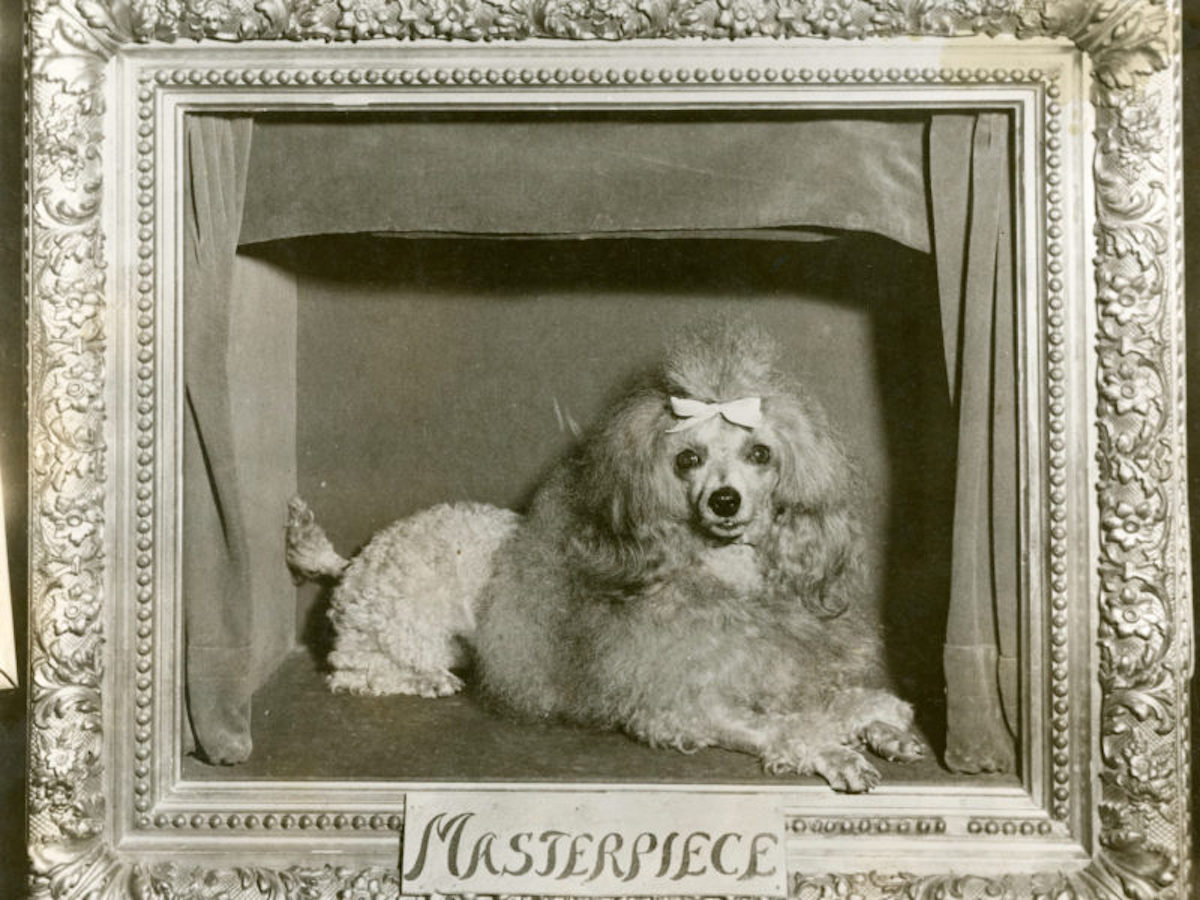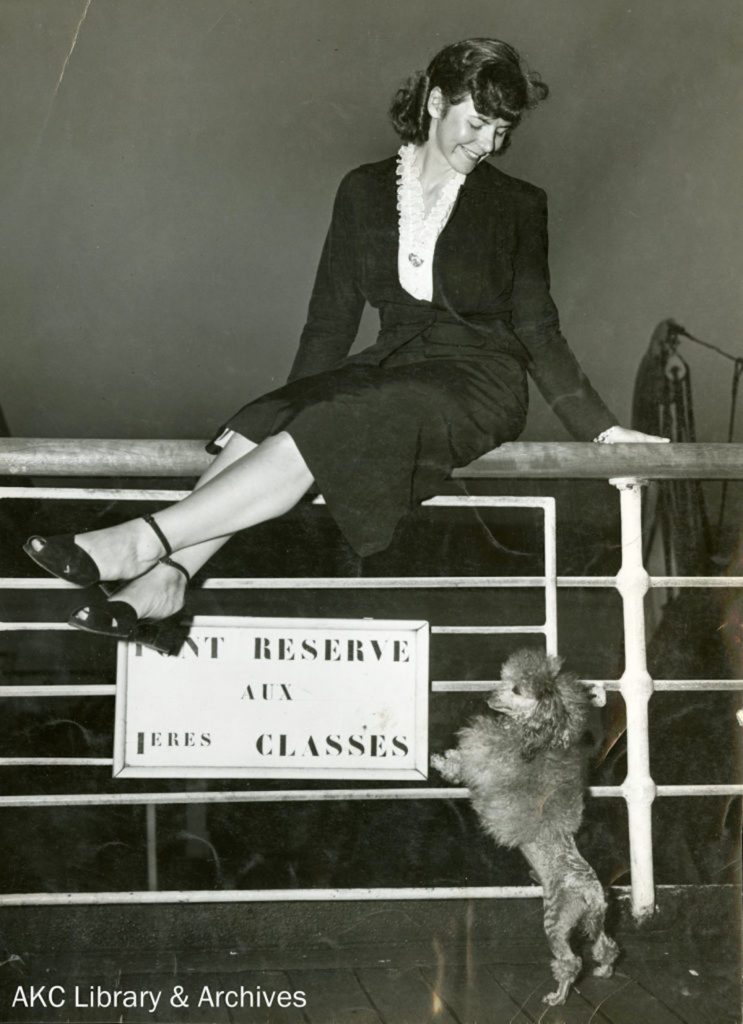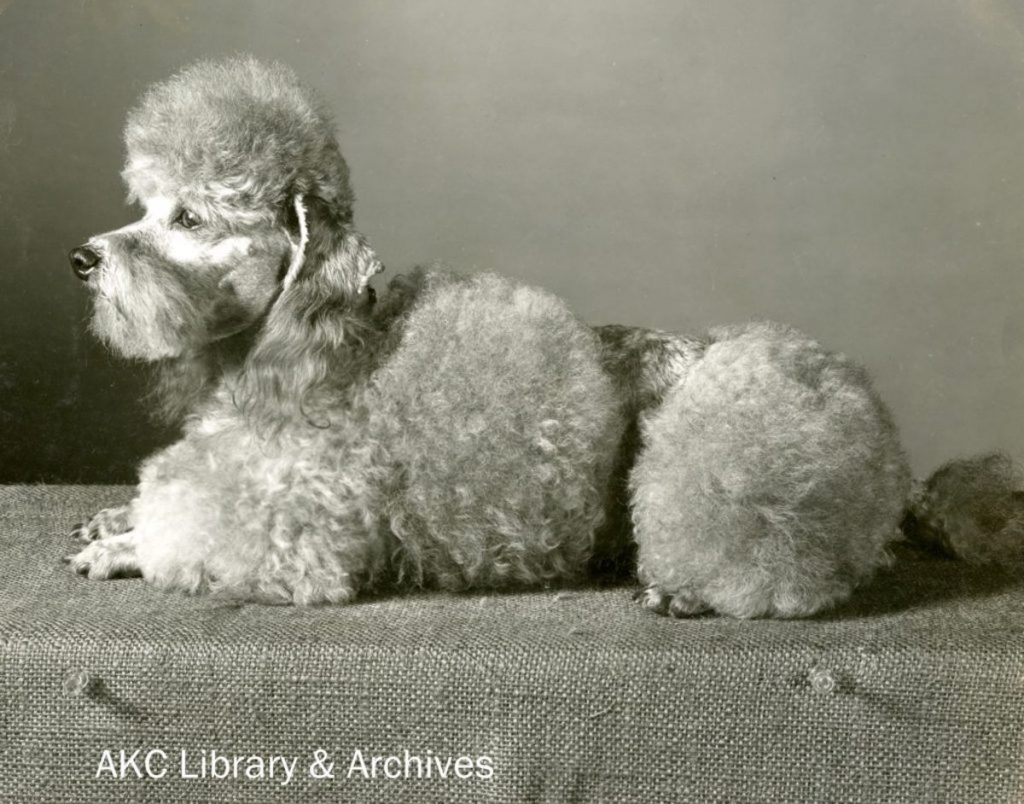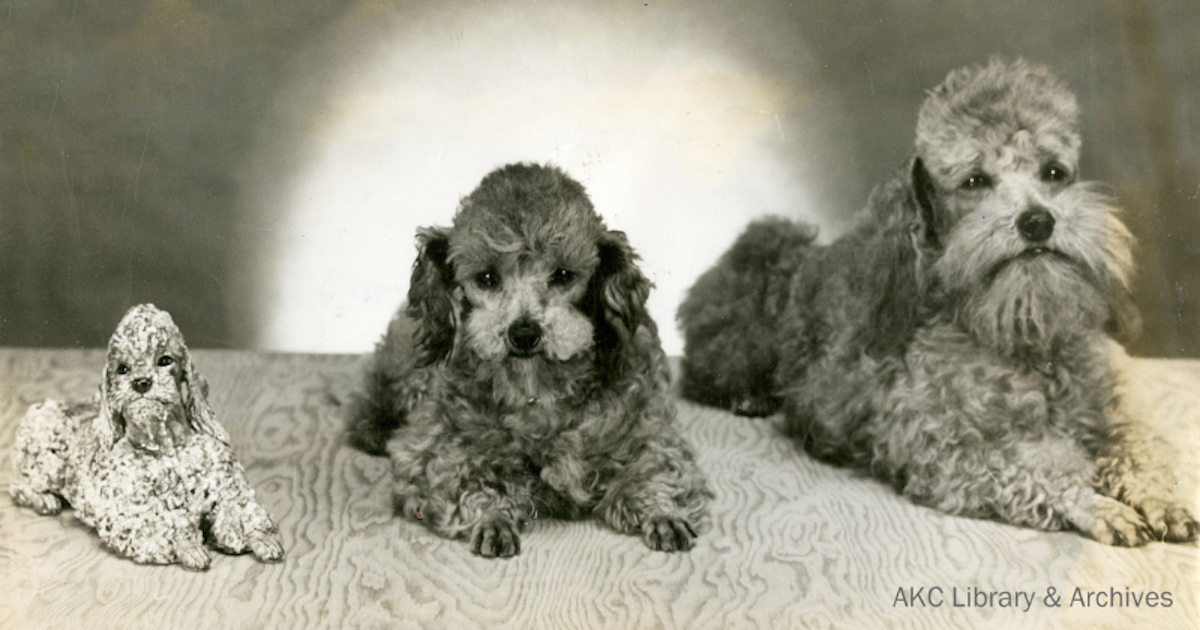Masterpiece – The World’s Most Valuable Dog
The Poodle ousted the Beagle as the AKC’s most registered dog breed. Its popularity can be traced back to the legendary Pulaski’s Masterpiece. Moreover, the dethroning was by one of the most decisive margins ever recorded in history. The ascension of the Poodle could largely be attributed to one 9.5-inch tall, eight-pound grey dog, which registered the highest appraisal value of any dog in history.
Pulaski’s Masterpiece is the story of this little dog and the man who identified within him charm, rareness, bravado, and talent so great that it forced him to share it with the rest of the world. This Masterpiece lays bare the true testament to the human-canine connection.
The tale also reveals the mystery and tragedy as the man-made a compelling case for the dog’s inherent specialness. Like other blatant self-promoters, this man, Count Alexis Pulaski, left a significant paper trail of his exploits. Some of it stirs up suspicion, for example, the claim that he was President Franklin Delano Roosevelt‘s personal groom, popularly known as Scottie Fala.
Another question is the designation of “Count,” which is suspiciously listed as his middle name on immigration records. Nevertheless, this review sticks to the provable truths in the process of creating a fairy tale. The real story does not need any hyperbole.

The Story of “Count” Alexis Pulaski a.k.a “Mr. Poodle.”
“Count” Alexis Pulaski was born just before the turn of the 20th century. According to early newspaper counts, he is referred to as a “White Russian.” This was term used to refer to Anti-Communists who fought the Bolsheviks in the Russian Civil War.
After they were defeated, he joined a large movement of exiles. According to naturalization records, he arrived in America in 1926. Pulaski was a classic aficionado, tall, cultured, and apparently born silver-haired despite his debatable title.
Pulaski had the gift of gab that the Post remarked that he was “the kind of man that could sell a crate of Boy Scout Handbooks to Nikita Khrushchev.” As a result, his intelligence and continental airs endeared him to New York society’s nobility.
Moreover, he tried out his hand in the overlapping world of dogdom. He selectively bred and showcased Doberman Pinschers as he had done on Russia since 1912. Apart from that, he also unsuccessfully ran a photography and grooming business.
As fate would have it, he switched his dog breed allegiance while babysitting his friend Gilbert Kahn’s Poodles, and he never looked back. He has stumbled into his calling! Pulaski established Poodles, Inc. at 51 West 52nd Street in 1945. Furthermore, he got financial support from Kahn and well-to-do heir and Poodle man, R. Stuyvesant Pierrepont.
The Poodle Company was based at Ha-Ha Club, which was the site of the former legendary speakeasy. It was just a few doors from the prominent 21 Club, which is still in operation. Poodles, Inc. brought together all the viable canine-related industries of that era.
As a result, it operated as a grooming salon, boarding kennel, and an upscale haberdashery of canine furnishings. However, it was not like the Canine Couturier close by because it strictly catered to its preferred breed.
Its exclusive approach gave Poodles, Inc. a social club air. Moreover, it served as an exhibition for the canines Pulaski had begun to breed based on what he referred to as the “pursuit of happiness” philosophy. The philosophy argued that the Poodle’s true purpose in life is to offer its master maximum pleasure.
The pinnacle of Pulaski’s vision came on August 4, 1946, when a litter was born. He was overwhelmed by the largest pup in the litter because of its carriage, demeanor, temperament, and charisma.
These features encouraged him to observe and train the pup for eight weeks. After that, he registered the grey dog with the ACK under the determined name “Pulaski’s Masterpiece.”
The Tale of Masterpiece the Poodle
Masterpiece made an unpromising debut in the Westminister’s puppy class in 1947. It just about survived an attack with discouragement that he was sent to recuperate in New Jersey for several weeks.
It took the pup a short time to recover and physically mature, and it collected enough points at the regional shows to achieve a championship title. According to Pulaski’s records, it added obedience and utility titles in a few short weeks. Pulaski also claims that it was the first toy dog to achieve the trifecta.
After that, Pulaski was determined to show the dog’s bravery beyond New York. So, he traveled to Los Angeles, Chicago, and St. Louis, where he was supposedly welcomed by parties having over 100 guests with an equal number of dogs.
Pulaski claimed that Masterpiece was destined for greater things. Thus, he invented a unique, masculine cut for the Masterpiece that exposed only the mid-rift. According to him, he did this hoping to cast the canine in less categorization light than the pom-pom Continental cut needed in the show ring.
Pulaski also custom-made an entire set of clothes for Masterpiece, including pajamas, raincoats, and bathrobes. Moreover, Pulaski was serving as a full-time press agent, so they assigned a bodyguard to Masterpiece. The bodyguard’s responsibilities included supervising its diet and hand-fed it during glum spells.
Apart from that, a personal beautician ensured Masterpiece got regular pampering and a former lion tamer who was imported to offer private tutoring in party tricks. Additionally, Lucy Copestake served as the traveling companion who saw the world with the pup.
Pulaski held cocktail parties at his Upper East Side apartment. It is reported that the parties included guests from Paris, Mexico City, Los Angeles, Budapest, Boston, Rio De Janeiro, and San Francisco. Moreover, the guests included press members, artists, investment bankers, veterinarians, and revelers.
Masterpiece performed on command during the parties, walking on his front or hind paws as it communicated using growls and grunts. One of the notable performances saw Masterpiece respond to the question “Are you a Communist, Masterpiece?” by shaking his head in energetic denial.
Pulaski stated that Masterpiece’s incomparable mental and muscular apparatus needed regular exercise and refining. Poodles Inc. displayed 20 paintings of Poodle fantasies as a nightclub harpist played in the background. The main focus was Masterpiece and his harem on top of decorative cushions keeping a stylish calm.
Pulaski’s Poodles needed not to be chained or confined. For example, they reposed at will, were sociable to all visitors, and their behavior demonstrated that they could be effortlessly trained to perfection.
Masterpiece’s carrying case was well thought out. It was designed as a deep picture frame applicable to its name and was eventually accompanied by armed guards at either side.
Masterpiece’s fame grew so much so, the Pakistani prince Ali Khan attempted to purchase it as a gift for his wife Rita Hayworth for a whopping 25000 USD. However, Pulaski shied away from the thought of parting with his adored companion.
Even so, that was not a reasonable price for Masterpiece as it earned 11000 USD annually as a model and stud dog. The earnings necessitated a bank account for Masterpiece at Chase National. Interestingly enough, Pulaski claims that Masterpiece refused to mate with a female for less than 500 USD by shaking his head. Later, it sired around 350 dogs.
The owners of Masterpiece brethren included Eva Peron, Judy Garland, and Gary Cooper. The legendary canine is reported to test and use all products he endorsed for Poodles, Inc. Some of the products it tested included towels, shampoos, matches, bowls, and a perfume known as “Kennel No. 9.
According to Lucy Copestake, when they arrived in Paris, Life magazine photographers popped up from all directions. Additionally, her phone received numerous press requests. They also received an invitation from designer Marcel Rochas to a show in which he presented a grey wool robe dress called “Masterpiece.”

The model marched down the runway to the platform and received the Master from Copestake, who performed delightfully. Unfortunately, Pulaski’s Masterpiece got unsettled by crowds at a local show. As a result, he had to be elevated on top of a 15-foot platform as it waited for police rescue.
On the other hand, Air France gave Masterpiece a farewell party for 20 friends at the airport’s restaurant. A special menu was prepared during the party, having a dish named in the cherished dog’s honor. The top dog received similar treatment in The Hague, Deauville, Antwerp, and Brussels.
Columnist Cholly Knickerbocker once gossiped that Masterpiece liked biscuits served au gratin. According to the columnist, the dog developed the habit during a trip to Paris where it pranced with royalty and became the first canine to ever lunch at the internationally renowned Maxim’s.
Pulaski’s Masterpiece was not just about fashion design. It acted as an ambassador of goodwill to Cuba, where it won a championship title. Moreover, it went to Haiti, where it received a gold medal from the government. It was also hosted at philanthropic fashion shows and events that support charitable courses like cancer and paralysis.
The Masterpiece fever continued to grow in its native land. One of Pulaski’s greatest shows, dubbed the “Miracle on 57th Street,” Masterpiece led a parade of its comrades from Poodle, Inc. to Fifth Avenue to Milgrim’s, a department store. The dogs joined an exhibition of faux fur articles modeled after the curled Poodle coat.
The show lasted from 9 in the morning to 6 at night with Pulaski Poodles in one window while Masterpiece occupied in a red velvet-lined shadow box. The store’s publicity director claimed that the inhabitants of mid-Manhattan suddenly became more Poodle-conscious for more than a week. Police intervention was required to control the screaming crowds.
In 1953, Masterpiece’s offspring Diego and Scusi went with Claire Booth Luce as American Ambassadors to Italy. Masterpiece had become dominant in talk shows which climaxed with a two-month-long spell co-hosting the “Dog Show of Champions” with Stella Stetson.
Masterpiece held its head above water each week as it came up against hunting retrievers and hounds, German Shepherd drill teams, and seeing-eye dogs. It also coped with a gang of Great Danes whom it leaped over with ease.
After that, it modeled Easter ensembles in The Dave Garroway show in what turned out to be its final public appearance. Several weeks later, in late May, Pulaski and his associates went downstairs to pass a message to a staff member of Poodles, Inc. Moments later, Pulaski invited his megastar to seduce clients that had strolled into the store. But, Masterpiece did not respond.
They frantically searched the store from top to bottom, but the superstar dog was nowhere to be found. At that moment, Pulaski declared that the greatest dog worldwide had vanished from the face of the earth!
At its disappearance, Masterpiece was only behind Rin Tin Tin and Lassie in terms of fame. Pulaski claimed that Masterpiece was the most valuable dog in the world that had grown into a household name. He added that his top dog was at the height of its beauty and manhood, but it was gone.
What Happened After Masterpiece Went Missing?
After the “most valuable dog in the world” vanished, Poodle, Inc. notified the police immediately. As a result, the police sounded a 13-state alarm. Newspapers ran headlines while Gotham Hosiery Company gave out 3500 flyers as they sought the return of their spokesdog.
Additionally, a generous reward was offered, including a promise of no questions asked. The search party was desperate to the extent that a puppy sired by Masterpiece was offered in exchange for returning the base Poodle.
A dog named Johnny was chosen from the remaining Pulaski stock as the dog that greatly resembled its father. It was offered during Pulaski’s television appearance in which he pleaded for the safe return of his adorable companion.
One person came forward with some credible information. The individual claimed to have seen a dark-haired woman in a red coat leaving Poodles, Inc. with a small grey dog. At the time, it was habitual to see a stylish lady with a Poodle submissively heeling by her side. However, this due caught the witness’s eye because they did not have a leash.
Pulaski would later bitterly reflect how Masterpiece used to obey anyone who issued commands in dog shows. This crime with few clues was even re-enacted on “The Dave Garroway Show,” where Masterpiece had become a recurring guest.
It slowly showed the beloved canine being removed from its cage, which is not mentioned in other remembrances of that notorious day. Could it be because of faulty memory, or was it just a falsehood in an attempt to make the Count seem less careless?
There was never closure or concrete clarification on Who, What, When, Where, Why, and How Pulaski’s Masterpiece disappeared into thin air. As a result, the saga remains an unresolved mystery. In this regard, the world might never really learn the fate of its most precious dog. Additionally, they will never know the kidnapper’s intentions.
Moreover, Masterpiece’s fans will never learn whether it was sold in the black market or lived out the rest of its precious life on a couch in another continent. Many other questions still lingering in the minds of many include:
- Was it impulsive or premeditated?
- Was it someone Masterpiece knew?
- Were the kidnappers vindictive or after money?
- Was it stolen for its excellent company?
One of the spiciest theories suggests that Masterpiece might have gotten tired of the pomp and chose to leave it all behind in exchange for a brief hiatus. This hypothesis is supported because it was not the first time the superstar dog had disappeared. Masterpiece had fled into the woods when it was nine months old.
The dog remained alone for three days in the New Jersey countryside before returning energetic and lively to the kennel’s doorsteps. One year later, as Pulaski ran an errand, Masterpiece strolled out of Poodles, Inc. and ran into a Park Avenue linen shop. The shop owners called the police, who returned it home.
Pulaski later admitted that Masterpiece was an intelligent dog that did not need much human supervision. In this sense, he acknowledged that his adorable dog was on an adventure from which he would never return. However, he couldn’t explain whether it was by its coherent choosing or not.
Mr. Poodle’s Grief and Recovery
How does one recuperate from such a loss? Pulaski issued yearly monographs that recounted Masterpiece’s doings. Many of the monographs were written in the first person by the icon dog. The first and last are kept at the AKC Library and Archives. He also claims that they were issued in time for the holidays, costing thousands of dollars each.
The monographs are, in reality, glorified booklets bound by staples. Additionally, the contents were copied from manuscripts straight out of Pulaski’s own typewriter. The final installment’s introduction states that the booklets have had a different color each year. With that in mind, the cover of the last booklet would be black- the traditional color for mourning.
However, the introduction also states that he does not think using the color black would be necessary because Masterpiece’s children, grandchildren, and great-grandchildren are still living among humankind.
Pulaski further states that Masterpiece will always be around in spirit. Therefore, he chose gold and green, which are typically used to denote hope. The hope was that Masterpiece would be returned home safe. But, above all, he was hoping that Masterpiece was alive and happy wherever he was.
Just Johnny was the undisputed heir apparent to Masterpiece’s publicity throne. The heir had a small amount of success as a 25 USD per hour model. Besides that, it graced the society pages as the “most photographed canine in New York.” However, it never reached the heights of its patriarch. After all, it was just Johnny and not Masterpiece.
A year after Masterpiece’s kidnapping, a reporter from Louisville, Kentucky visited Pulaski and discovered that the security at Poodles, Inc., had been beefed up. Additionally, the facility has evolved into a shrine that is devoted to its departed mascot. However, the reporter also stated that Masterpiece’s green velvet canopy bed still sat in the corner.
Moreover, the walls were papered with photos. Poodles, Inc. had recently held a birthday party for its guest of honor in absentia. Pulaski brought the curtains down on the store in 1956. However, the cultural revolution it had stirred a different way of choosing, pampering, and adorning furry friends carried on.
Enter Worldwide Poodle Fever
The Poodle was not a significant factor in the era of American purebred dog ownership and exhibition; its iconic status notwithstanding. Finally, however, the Poodle began gaining traction among the dog fancy as Charlotte Hayes Blake Hoyt won its first Best in Show win at Westminister in 1935.
After that, Hoyt stated that the Poodle was not fancied in the early 1900s fashionable society. Additionally, he claimed that most members of the society had common discrimination against it. The prejudice was severe that in 1929, kennels that raised them gave away more Poodles than they sold.
There was a general feeling that the Poodle was more of a sissy type of dog that belonged to the Victorian Age. However, pioneers such as Hoyt of Blakeen Kennels and Alene Stern Erlanger of Pillococ Kennels developed vital breeding programs despite the challenges. These programs multiplied, resulting in growth from 50 Poodles registered with the AKC in 1930 to 3195 in 1950.
Poodles are also appreciated for bringing the concept of dog obedience to the United States. The concept was used in early exhibitions performed for the American public by Helen Whitehouse Walker and Blanche Saunders from 1937. The Poodle’s intelligence and high trainability were on display in the 18th and 19th centuries.
These attributes were ignored as the Poodle became a fashion plate in the 1950s. Elizabeth Taylor, who was the superstar at the time, has modeled her shot gamine haircut after her pet Poodle. Her performance inspired many copycats.
Additionally, reports from Abercrombie and Fitch and Saks Fifth Avenue suggested that Poodle owners spent more on their furry friends than other dog owners. On the other hand, Poodles were reported to outnumber other dog breeds in Manhattan restaurants like The Colony.
The Poodle became so popular that one paper insinuated that once a girl makes it in life, she would typically get three things: gems, minks, and a Poodle. This trend was not like any other trend because it was based n traceable reason and logic.
For instance, the breed has a desirable temperament and obedience, and it can cater to a wide range of aesthetic needs and inclinations. Furthermore, Poodles offer more customization options than other dog breeds because they come in three sizes, namely:
- Toy
- Miniature
- Standard
Besides that, they also come in a variety of coat colors. The Poodle creates the sense that you could abide by current trends while tailoring your own. There were also rinses in the market that allowed Poodle owners to dye their pup’s coat to their desired color.
Pulaski thought the rinses were a bit uncouth and instead offered at least 17 different haircut styles for the Poodles. One of the most popular styles by Pulaski was “The Mae West,” which mirrored after the disreputably rude personality of stage and screen and the “Sailor Clip” for the bell bottom effect in its legs.
The Rise of the Modern Pet Owner
The use of dogs as accessories became trendy, and so did accessories for the dogs. Pulaski’s designer for Masterpiece’s wardrobe, Mildred Pell, took her products to Hammacher Schlemmer and Bloomingdales. The retailers were unconvincing at first until they all sold, forcing Pell to look for extra hands.
In 1960, a top newspaper ran a trend piece that covered the indulgence of pet owners. The article had a half mystified and half skeptical tone. According to the story, Americans spent 150000000 USD every year on dog accessories. The paper attributed the increase to the abundance of luxury items, including four-poster canopied beds, canine cologne, and black velvet opera capes.
Moreover, New York was the hotbed of excessive enthusiasm. An anonymous individual from Manhattan commented on the overzealousness stating that it was embarrassing in New York City if your dog did not have a nice velvet blazer.
According to Yellow NYC Pages, the city is host to 41 “Dog and Cat Furnishings” establishments, 30 dog beauty parlors, and 83 dog kennels. But, of course, these numbers don’t cover the dog departments of sporting goods and department stores.
It was also reported that a third of dogs in New York were purebred. The reports also revealed that the Poodle was among the most popular breed. Recently, the Poodle rose to become the most registered breed with AKC and by the biggest margin ever recorded.
The reports also credited much of the development to Alexis Pulaski, who returned to take advantage of the new trends after four years of grieving. The “Count” returned to business with his old passion and sold his dogs for as high as 3000 USD.

The Tale End of it
Later in 1960, Pulaski followed through his vision of devising an indoor bathroom for small dogs to the disbelief of many. Reports claim that the toilet could fit neatly under the sink of the bathroom. It was also able to flush water against the inside walls and floor automatically. But, his invention did not take off.
Pulaski resorted to seeking media attention through rabble-rousing. As a result, he ended up as an outsider among the dog lovers. Some considered him to be a nuisance, while others deemed him to be a harmless kook.
After that, Pulaski devoted his energy to his opus, “Pulaski on Poodles.” He intended it to be an exhaustive breed history. Moreover, he wanted it to be a critical practical guide on breeding and care of Poodles. However, publishers rejected his piece as they deemed it to be too similar to existing ones.
Besides that, a note backs the claim that Winston Churchill, a Poodle enthusiast himself, had requested a copy of the publication. However, he never received the manuscript as Pulaski’s dream of publishing never came to pass.
Even though years of rebuff and ridicule have taken their toll on Pulaski, the “Count” is stands undeterred and fights on with absolute heartiness. In 1968 June, the Poodle enthusiast was reported dead at the age of 73.
In the same year, he had appeared in the New York Times feature on the popularity of the Poodle. At that time, he had stopped traveling the world but was still in the company of his dogs. Besides that, he also appeared on signs for several kennel clubs, old newspaper clippings, and scrapbooks.
His obituary reduced his legacy to Masterpiece, an opinion he would have likely approved. Yet, at one time, he admitted that he did not have many talents and abilities to achieve long-term value in the world.
As a result, he concluded that his contribution would come through dogs. In “Pulaski Poodles,” he had initially titled his Masterpiece chapter “The Story of an Amazing Dog.” But a handwritten edit on the manuscript changes it to “The Saga of the Masterpiece.”
Despite his exaggeration and hullabaloo, the grieving “Count” emerges as someone awfully relatable to any pet parent that has suffered the loss of their pet. He acknowledges that the dog is indeed dead and could be misunderstood as boasting by celebrating it.
However, he reiterates that he is only praising his “little friend,” Pulaski’s Masterpiece. In the end, Pulaski reminds his readers that Masterpieces are not everyday and, therefore, they should be treasured. Dog fanatics would have forgotten this intriguing forgotten tale were it not for the Poodle Club of America, which donated the Alexis Pulaski scrapbooks and other items from its collection to the AKC.
